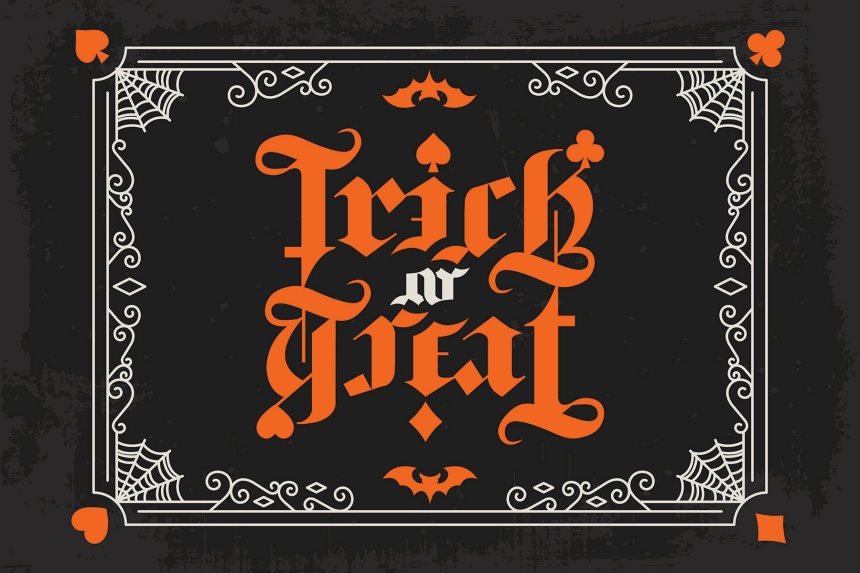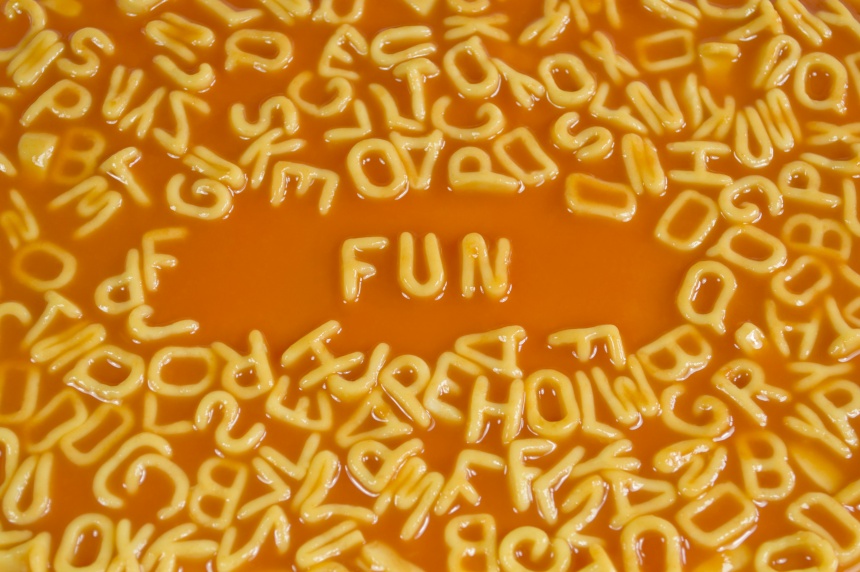A lot has been said and written over the last couple months about the online word game Wordle. It has become so wildly popular that other programmers have been busy building their own takes on the concept. (See, for example, Quordle, Sedecordle, Absurdle, and, for a mathematical twist, Nerdle.)
Wordle is a fun diversion for lovers of wordplay — I play it myself — but it suffers from two inherent problems: 1) You only get one a day. 2) You have to get on the internet to play it.
But wordplay has existed since long before computers were invented — before typewriters were invented, even. All you need to play with words is something to write on, something to write, and your own creativity. That’s why I believe words are the best toys.
Here are a few of my favorite ways to play with words:
The -grams
The noun-forming element -gram traces back to the Greek gramma, meaning “that which is drawn or written,” which itself comes from the word graphein “to draw or write.”
Anagrams
Anagrams are the classic letter rearrangement puzzles. The ana- prefix means “back, backward,” so the literal translation of no longer describes exactly what we mean by the word. (We’ll see this prefix again soon.) In an anagram, you can rearrange the letters in a word in any order, not just backward, to create another word.
One joy of anagrams is finding pairs of anagrammatic words that bear some other relationship as well, such as being synonyms (angered/enraged); antonyms, sometimes called antigrams (funeral/real fun); or that otherwise seems to describe one another (the eyes/they see). And as you can see, you don’t have to limit anagrams to single words, and a little time and thought can lead you to some anagrammatic statements that you won’t at first believe. For instance,
- The Great New York Rapid Transit Tunnel = Giant work in street, partly underneath
- A domesticated animal = Docile, as a man tamed it
- Vacation times = I’m not as active
- Eleven plus two = twelve plus one (both anagrammatic and mathematically accurate, and the anagram uses 13 letters!)
Some people have even had their fun by anagramming, line by line, Shakespearean sonnets.
Another fun place to try anagrams is on names. Consider these:
- Matthew McConaughey = A “catch them women” guy
- Clint Eastwood = Old West action
- David Letterman = Nerd amid late TV
Any lover of wordplay ought to know at least one anagram of their own name. My full name anagrams to “O Burn and Blacken the World” (fun, right?). What anagrams can you make from your name?
Pangrams
Of late we haven’t been able to get away from the pan- prefix, which means “all,” because of the ongoing pandemic. More enjoyable are pangrams, words, phrases, or sentences that use all the letters in a given set. Usually, pangram indicates a statement that uses all 26 letters of the alphabet at least once. The challenge is to make the statements as brief as possible. Maybe you’ve heard some of these:
- The quick brown fox jumps over the lazy dog.
- Pack my box with five dozen liquor jugs.
- A quart jar of oil mixed with zinc oxide makes a very bright paint.
- Jack’s frozen-lab-themed party was quite extravagant.
If you’ve got a Scrabble game at home, you can attempt another type of pangram: Limit yourself to the 100 tiles that come with the game (you’ve got two blank tiles to help you out) and use them all to build a sentence or poem, or just try to see how few words you can create that use all the tiles. The challenge here is that you cannot repeat a letter if you don’t have another tile for it.
Lipograms
From a certain point of view, a lipogram is the opposite of a pangram; instead of using all the letters, you intentionally try to avoid using letters. The lipo- comes from the Greek leipein “to be lacking.” For a lipogram, the goal is to craft a complete composition that avoids using a particular letter or letters of the alphabet.
You can avoid using Qs, Xes, and Zs all day long (barring their direct mention in this sentence, these three letters don’t appear at all in this section). The traditional challenge is to avoid using the most commonly used letter in the alphabet: E. It can be done: Ernest Vincent Wright’s 1939 novel Gadsby is a 50,000-word story that does not contain the letter E.
For another fun romp through both pangrams and lipograms, read Mark Dunn’s 2001 novel Ella Minnow Pea.
Isograms
The iso- prefix means “same, equal.” Generally, an isogram is a word or phrase in which each letter occurs only once, as in ambidextrously, copyright, and Michael J. Fox. Technically, though, an isogram is a word or phrase in which each letter appears the same number of times. For example, Anna’s deeds is an isogram because it contains five letters that are each used twice. (It’s worth noting that the word isogram is itself an isogram, making it autological.
Composing an isogrammatic sentence, or something even longer, is very difficult, but the sense of accomplishment from achieving it could be great. Good luck!
Ambigrams
Coined in 1983 by Pulitzer Prize-winner Douglas Hofstadter, ambigram uses the Latin prefix ambi-, meaning “both, both sides,” and is more of a calligraphic puzzle than straightforward wordplay. Ambigrams are renderings of words that can be oriented in two ways. In its usual form, an ambigram can be turned completely over and will still look the same.

Another fine example appears on the front of the 20th anniversary edition DVD of The Princess Bride.
The -dromes
The Greek dromos means “a running,” and the word part that you append its modern English equivalent to indicates where, what, or how the wordplay runs.
Palindromes
Palin- indicates “again,” so a palindrome “runs again” — that is, it’s a word or phrase that can run the same in either direction. Single-word palindromes like racecar and deleveled are a good start, but logophiles have been building longer and more elaborate palindromes for centuries. Here are a smattering of fun ones:
- A man, a plan, a canal — Panama!
- Was it a rat I saw?
- Ma is as selfless as I am.
- Are we not drawn onward, we few, drawn onward to new era?
There’s even an annual award for the year’s best palindromes, fittingly called the Symmys, so start building your best symmetrical sentences today!
Anadromes
An anadrome (using the same “backward” ana- that we saw on anagram) is a word that spells a different word backward. Some examples are stressed/desserts, drawer/reward, and pupils/slip-up. Anadromes themselves can be fun to tinker with, but recognizing them can be a key to building up longer palindromes.
Some people like to call an anadrome a semordnilap — palindromes spelled backward — but the name hasn’t really caught on. They’re also called heteropalindromes, which is just too long a word.
If you spend any time on social media, you’ll occasionally yourself reading a poem that is intended to be read first from top to bottom (as normal) and then from bottom to top, one line at a time. This could be considered a type of anadrome. Beyond that, though, I have not seen any anadromes that deliver a backward message either reading word by word or letter by letter. Give it a try; you could make a name for yourself among logophiles!
Other Wordplay
Spoonerisms
Spoonerisms are phrases in which the initial sounds of two words are transposed, leading to an intentional or accidental comical effect. They were named for the Rev. William A. Spooner, a turn-of-the-century warden of the New College, Oxford, who was known for making this sort of blunder.
George Carlin once encouraged his audience, “Don’t sweat the petty things and don’t pet the sweaty things.” But spoonerisms don’t have to be so meaningful or well-balanced. If you’ve ever asked for a “look bite” instead of a book light or said that you’re going to “shake a tower” when you plan to take a shower, you’ve built some fine spoonerisms.
Tom Swifties
Tom Swift was the main character in a series of books that began publication in 1910. At least one of the series writers (of which there were multiple, but they all wrote under the alias Victor Appleton) seemed to want to either avoid or dress up the bare dialogue marker said, often by adding an adverb after it. A Tom Swifty parodies this style and creates a pun between the quotation and the quote marker.
Because adverbs often end in -ly, this type of quip was originally called Tom Swiftly — as in “‘We’ve got to go faster!’ said Tom Swiftly” — but now they’re more commonly called Tom Swifties. Unless the name is part of the pun, though, Tom is usually made the speaker of the quote.
Here are a few to give you an idea of what fun they can be:
- “It’s like a sauna in here,” Tom said heatedly.
- “Welcome to my tomb,” Tom said cryptically.
- “Where’d Garfunkel go?” Paul said artlessly.
Tom Swifties aren’t always about the adverbs, though:
- “This candy bar is delicious,” Tom snickered.
- “I’m getting off this flight,” Tom explained.
- “I won’t ring this bell anymore!” Tom extolled.
Play with these infinite toys, words, for a while and share what fun things you find in the comments section. Or, put into a pangram:
No joke, friend: We expect you to share your very best quips, puzzles, and wordplay gems.
Featured image: Shutterstock
Become a Saturday Evening Post member and enjoy unlimited access. Subscribe now



